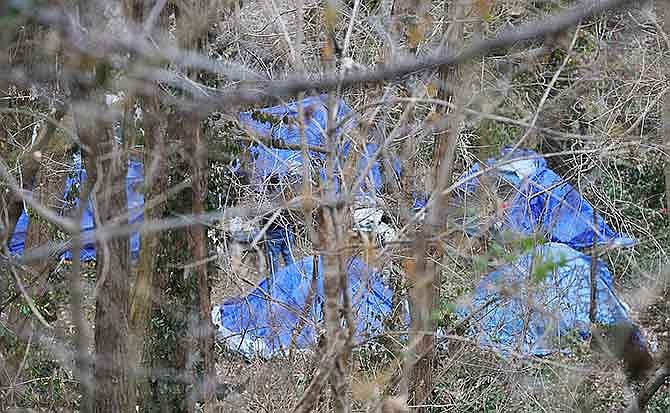Four men and two dogs live in tents behind Jefferson City's Hamilton-Dulle Towers down a steep ravine just before the train tracks.
Their camp is made of tents that are insulated in blankets and covered in blue tarps. Along the side of the camp the residents have dug a drainage ditch to divert a stream around the camp, rather than through it. The site is guarded by ever-watchful canines Marley and Bear, which will bark at any unfamiliar person who approaches, but they calm down once the camp members make their introductions.
"We know how to survive," said Pat Davidson, 58, camp resident. "We have all camped out before, but it gets a little tougher in winter."
Davidson has been in Jefferson City for the past 15 years. He previously worked in construction and still does odd jobs and handyman work for churches or anyone who will hire him. But after injuring his back, he is not able to do as much as he once was, he said.
Before the gang made their most recent camp by the towers, they were about 60 yards down, closer to the Federal Courthouse. They were forced to move off of the land by federal marshals, Davidson said.
They share food, get some relief from local food pantries, and take occasional trips to the Salvation Army to outlast the cold weather. They spend time at the library during the day. They occasionally are helped by good Samaritans, such as the railway worker who recently stopped by the camp to deliver pizza, dog food and some bones. But also, occasionally, they are targeted by more nefarious types, such as the person who slashed Davidson's tent to shreds, or the thief who stole another tent that belonged to Bob Kirby, 53.
"They (people) know we are out here; they just don't care," Kirby said. "Well, some just don't care. ... There are a lot of people camped out like this all over town, but you just don't see them. They are hiding out."
Another camp resident, Tim Rigby, 52, used to live beneath the bridge over the Missouri River. He lived there for six years, he said. He watched them build the walkway along the bridge; he survived snow storms, and avoided being vacated by the police. However, he relocated after a Missouri Department of Transportation worker went through the court system to remove him from the place, he said.
All three men have experience with maintenance and construction. Davidson has a long history in construction for residential homes. The same goes for Kirby, plus some experience in truck driving, he said. Rigby was once certified to do electrical work and has a lot of experience with roofing, he said.
"I have been in Jeff City for 17 years, and I was stunned at the level of homelessness that we discovered through our community meals, because we just don't see it," said Jim Hill of the First Baptist Church (FBC).
The FBC facilitated the first meeting of the Jefferson City Homelessness Task Force and served as a catalyst for the task force's creation. The church officials decided to help the homeless community after feeding possibly more than 100 people every time they had a community meal, Hill said. They did not want to reinvent or recreate a service already offered, so they conducted a sort of survey with all the other organizations and found that the relief efforts were not coordinated.
Soon after they got the groups together and started talking about ideas to help. Their first meeting was in September, and their next one will be the fourth time they have convened. They are joined by other non-religious agencies and other Christian churches, but the task force is open to everyone.
"Anybody interested in working on homelessness would be welcomed to the task force," Hill said. "Ultimately the group wants to create services and programs that address the ongoing needs of the homeless in our community, and they are not interested in a Band-Aid approach. ... I am really excited about what is happening with this, and there is a lot of expertise in the group."
With each meeting, the task force has grown, from 20 to 30 people at first to nearly 60 members now, Hill said. Some of the homeless community even attends to offer insight to their problems. The members of the task force are divided into three groups:
The first subgroup is to promote and train homeless advocates who can work with homeless people and connect them with needed resources.
The second subgroup is to raise awareness and educate the community, while also putting a comprehensive and evolving list of resources together for the first group to use.
The third and final subgroup is to expand and diversify shelters for the homeless.
"We need emergency shelter and more shelter because the Salvation Army is our only shelter and it is over capacity all the time," Hill said. "Winter is coming and it is very cold, and the idea of people living outside in this kind of weather is really on the hearts of a lot of the people on this task force."
At the moment, the task force is toying with the idea of using the churches as temporary emergency shelter for the cold weather, but this may be problematic due to the diversity of the homeless population as well as the different needs of shelters. To keep people safe at shelters usually requires shelter managers to separate the shelter residents or allow only specific demographics of people in the facility. For example, some shelters allow only women, while others have only single men, some have families and others house only the mentally ill.
The next meeting for the task force is at 9 a.m. Jan. 17 in the Missouri River Regional Library. However, the shelter subgroup will meet at 9 a.m. Dec. 13 in the First Presbyterian Church. All are welcome.

